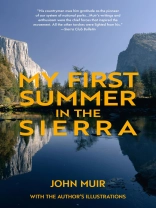My First Summer in the Sierra is perhaps the most lyrical, joyous, and engaging of all John Muir’s many works. In the summer of 1869 Muir took work as a sheepherder in order to explore the headwaters of the Merced and Tuolomne Rivers. Keeping notes in the form of a diary, Muir describes his fellow companions-human and otherwise-with exquisite compassion, interest, awe, and even humor. This Warbler Classics includes all of the sketches by Muir that appeared in the first edition of the book and a detailed biographical note.
Table des matières
Contents
Illustrationsvii
Chapter I
Through the Foothills with a Flock of Sheep1
Chapter II
In Camp on the North Fork of the Merced16
Chapter III
A Bread Famine39
Chapter IV
To the High Mountains44
Chapter V
The Yosemite60
Chapter VI
Mount Hoffman and Lake Tenaya79
Chapter VII
A Strange Experience95
Chapter VIII
The Mono Trail105
Chapter IX
Bloody Cañon and Mono Lake116
Chapter X
The Tuolumne Camp125
Chapter XI
Back to the Lowlands138
Biographical Note144
A propos de l’auteur
John Muir (1838-1914) was a Scottish-born American naturalist, writer, and advocate of U.S. forest conservation. As early as 1876 Muir urged the federal government to adopt a forest conservation policy. In 1890, due in large part to Muir’s efforts, an act of Congress created Yosemite National Park and. In 1892 Muir and a number of his supporters founded the Sierra Club, an organization devoted to protecting the environment. He served as its first president, a position he held until his death in 1914. Muir’s personal involvement was instrumental in the establishment of many of the country’s other national parks: Sequoia National Park, the Petrified Forest, Muir Woods National Monument, and Grand Canyon National Park. John Muir died in Los Angeles on December 24, 1914, of pneumonia at the age of seventy-six. His writings continue to serve as sources of inspiration for naturalists and conservationists the world over and remain important works in the body of literature on America’s natural history.












